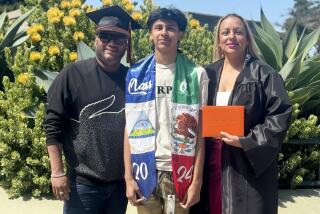Editorial: Countless Americans carry guns. Police are killing too many of them
- Share via
Many justifications are being offered for the tragic police shooting on Thanksgiving night that killed 21-year Emantic Fitzgerald Bradford Jr. at the Riverchase Galleria in Hoover, Ala., just south of Birmingham. They all seem beside the point.
Bradford, known as E.J., was among the shoppers who crowded the mall on Thursday when, police say, gunshots wounded an 18-year-old man and a 12-year-old girl. Bradford apparently was armed. Police showed up on the scene and shot him, and announced that in doing so, they had ended the threat. They later acknowledged that Bradford had not been the shooter. But they claimed that he had “brandished” his gun at the scene, leading to a “heightened sense of threat” in an already dangerous situation.
Certainly, if a man holds a gun at the scene of a shooting, police are more likely to zero in on him than on others. Officers arrive in the midst of extremely tense, life-threatening and fast-moving situations and must think quickly.
The legal standards for professional negligence in policing, and the training that goes with them, should be toughened up.
Yet guns are ubiquitous in this nation, whether we like it or not. Many people carry them legally, and for just this kind of situation — to be the “good guy with a gun” who stops the armed bad guy. No less than the president of the United States has called for more armed citizens, so that in the midst of an altercation, many guns might be wielded by good guys and bad guys alike. Officers should expect it. They should be trained for it.
Police are human, but they are also specialists. It should not be asking too much to require them to understand who they are about to shoot at before pulling their own triggers — not just in spite of the chaos that’s inherent at the scene of a fight but precisely because of it. They represent the law and they represent order. That’s what they should be expected to bring to a scene of violence and confusion.
It’s not yet clear whether Bradford was an armed “good guy” who pulled his weapon to protect himself and others when he heard shots fired. In any event, although we don’t buy the “good guy with a gun” approach to safety, it’s tempting to wish that there were some kind of uniform that the good guys who do have guns could wear that would identify them to officers as such, to keep them safe when they are trying to keep others safe.
But that’s just a fantasy and, besides, we have tragic evidence that no designation, no marking, would suffice. Earlier this month, shots were fired during a fight at a Chicago bar and security guard Jemel Roberson apprehended one participant. Witnesses said his clothing was clearly marked “security.” Police arrived, saw Roberson with a gun, and shot him dead. He was not merely a good guy with a gun, but a security professional. That didn’t save him.
Bradford and Roberson were both armed African American men, and, according to one line of thinking, that is what doomed them. Remember Philando Castile, the black motorist who was shot to death by a Minnesota police officer in 2016 after calmly and prudently advising the officer that there was a firearm in the car. In that case there was no altercation other than the one instigated by the police officer — just a black man with a gun.
There is plenty of evidence to support the contention that the use of force by police is meted out differently according to race. A 2016 analysis by the National Bureau of Economic Research, for example, found that blacks and Latinos are more than 50% more likely to experience force from law enforcement officers than their similarly situated white counterparts.
Enter the Fray: First takes on the news of the minute from L.A. Times Opinion »
So it would stand to reason that police kill proportionately more blacks than whites — yet that may not be the case. The same study concludes says that when it comes to lethal force, blacks and whites are treated about the same.
Squaring those two conclusions is a difficult exercise, and perhaps evidence of the complexity of race in America.
But there is still much more studying to be done before scholars have a full grasp of the situation. What this study and many others do show is that police shoot and kill many hundreds of people each year of all races — numbers far higher than in other developed nations. It’s a signal that the legal standards for professional negligence in policing, and the training that goes with them, should be toughened up.
Follow the Opinion section on Twitter @latimesopinion and Facebook
More to Read
A cure for the common opinion
Get thought-provoking perspectives with our weekly newsletter.
You may occasionally receive promotional content from the Los Angeles Times.









